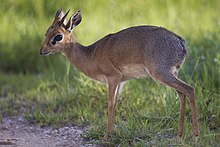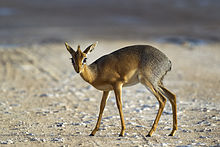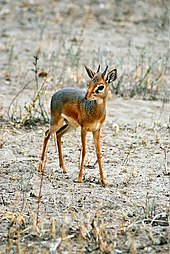Dik-dik
| Dik-dik | |
|---|---|

| |
| A maleKirk's dik-dikatEtosha National Park,Namibia | |

| |
| Female mate of the male dik-dik in the above picture | |
| Scientific classification | |
| Domain: | Eukaryota |
| Kingdom: | Animalia |
| Phylum: | Chordata |
| Class: | Mammalia |
| Order: | Artiodactyla |
| Family: | Bovidae |
| Subfamily: | Antilopinae |
| Tribe: | Neotragini |
| Genus: | Madoqua (Ogilby,1837) |
| Type species | |
| Antilope saltiana Desmarest, 1816
| |
| Species[1] | |
| Synonyms[2] | |
| |
Adik-dikis the name for any of four species of smallantelopein thegenusMadoquathat live in the bushlands of eastern and southern Africa.[1]
Dik-diks stand about 30–40 centimetres (12–15.5 in) at the shoulder, are 50–70 cm (19.5–27.5 in) long, weigh 3–6 kilograms (6.6–13.2 lb) and can live for up to 10 years. Dik-diks are named for the alarm calls of the females. In addition to the females' alarm call, both the male and female make a shrill, whistling sound. These calls may alert other animals to predators.
Name
The namedik-dikcomes from anonomatopoeiaof the repetitivediksound female dik-diks whistle through their long, tubular snouts when they feel threatened.[3]
Physical characteristics
Female dik-diks are somewhat larger than males. The males havehorns,which are small (about 7.6 centimetres or 3 in), slanted backwards and longitudinally grooved. The hair on the crown forms an upright tuft that sometimes partially conceals the short, ribbed horns of the male. The upper body is gray-brown, while the lower parts of the body, including the legs, belly, crest, and flanks, are tan. A bare black spot below the inside corner of each eye contains apreorbital glandthat produces a dark, sticky secretion. Dik-diks insert grass stems and twigs into the gland to scent-mark their territories.
Perhaps to prevent overheating, dik-diks (especially Guenther's dik-diks) have elongated snouts with bellows-like muscles through which blood is pumped. Airflow and subsequent evaporation cools this blood before it is recirculated to the body. However, this panting is only implemented in extreme conditions; dik-diks can tolerate air temperatures of up to 40 °C (104 °F).[4]
Adaptations for desert environments
Dik-diks have special physiological adaptations to help them survive in arid environments.[5]For instance, dik-diks have a lower density of sweat glands compared to other animals such as cattle.[5]Similarly, in more arid environments, dik-diks can concentrate their urine.[5]These adaptations help dik-diks preserve body water.[5]Because of their small body size, dik-diks are predicted to have among the highest metabolic rates and highest energy requirement per kilogram of allruminants.[6]However, dik-diks have a lower metabolic rate than would be predicted for their size as a physiological adaptation to heat and aridity.[6]
Habitat
Dik-diks live in shrublands and savannas of eastern Africa. Dik-diks seekhabitatswith a plentiful supply ofedibleplants such asshrubs.Dik-diks may live in places as varied as dense forest or open plain, but they require good cover and not too much tall grass.[7]They usually live in pairs in territories of about 5 hectares (12 acres). The territories are often in low, shrubby bushes (sometimes along dry, rocky streambeds) with plenty of cover. Dik-diks, with their dusty colored coat, are able to blend in with their surroundings. Dik-diks have an established series of runways through and around the borders of their territories that are used when they feel threatened.[8]
Diet



Dik-diks areherbivores.Their diet mainly consists offoliage,shoots,fruitandberries,but little or no grass. They receive sufficient amounts of water from their food, which makes drinking unnecessary. Like all even-toed ungulates, they digest their food with the aid of micro-organisms in their four-chambered stomachs. After initial digestion, the food is repeatedly eructated and rechewed, a process known also as rumination, or 'chewing the cud'. Dik-diks' tapering heads may help them eat the leaves between the spines onacaciatrees, and feed while still keeping their head high to detectpredators.[4]
Reproduction
Dik-diks are monogamous,[9][10]and conflicts between territorial neighbors are rare. When they occur, the males from each territory dash at each other, either stop short or make head-to-head contact, then back off for another round, with head crests erected. Males mark their territories with dung piles, and cover the females' dung with their own.[10]One suggestion for monogamy in dik-diks is that it may be an evolutionary response to predation;[11]surrounded by predators, it is dangerous to explore, looking for new partners.[12]Pairs spend about 64% of their time together. Males, but not females, will attempt to initiate extra-pair mating if an opportunity arises.[9]
Females are sexually mature at six months and males at 12 months. The female gestates for 169 to 174 days and bears a single offspring. This happens up to twice a year (at the start and finish of the rainy season). Unlike other ruminants which are born forefeet first, the dik-dik is born nose first, with its forelegs laid back alongside its body. Females weigh about 560 to 680 g (1.23 to 1.50 lb) at birth, while males weigh 725 to 795 g (1.598 to 1.753 lb). The mother lactates for six weeks, feeding her fawn for no longer than a few minutes at a time. The survival rate for young dik-diks is 50%. The young stay concealed for a time after birth, but grow quickly and reach full size by seven months. At that age, the young are forced to leave their parents' territory. The fathers run the sons off the territory and the mothers run off the daughters.[13]
Predators
Dik-diks are hunted byleopards,caracals,lions,hyenas,wild dogsand humans. Other predators includemonitor lizards,cheetahs,jackals,baboons,eagles,hawksandpythons.Dik-diks' adaptations to predation include excellent eyesight, the ability to reach speeds up to 42 km/h (26 mph), and high birth rates.[8]
Species
The four species of dik-dik are:[1]
- Madoqua guntheriThomas,1894–Günther's dik-dik
- M. kirkii(Günther,1880)–Kirk's dik-dik
- M. piacentiniiDrake-Brockman, 1911–Silver dik-dik
- M. saltiana(de Blainville,1816)–Salt's dik-dik
References
- ^abcGrubb, P.(2005)."GenusMadoqua".InWilson, D.E.;Reeder, D.M (eds.).Mammal Species of the World: A Taxonomic and Geographic Reference(3rd ed.). Johns Hopkins University Press. pp. 683–684.ISBN978-0-8018-8221-0.OCLC62265494.
- ^Madoqua.Retrieved through:Interim Register of Marine and Nonmarine Generaon 24 May 2022.
- ^"9 Fun Facts About the Dik-Dik".mentalfloss.com.15 July 2014.Retrieved20 March2018.
- ^ab"Dik-dik | African Wildlife Foundation".www.awf.org.Retrieved25 June2024.
- ^abcdMaloiy, G. M. O. (1973)."The Water Metabolism of a Small East African Antelope: The Dik-Dik".Proceedings of the Royal Society of London. Series B, Biological Sciences.184(1075): 167–178.Bibcode:1973RSPSB.184..167M.doi:10.1098/rspb.1973.0041.ISSN0080-4649.JSTOR76120.PMID4148569.S2CID36066798.
- ^abMaloiy, G. M. O.; Rugangazi, B. M.; Clemens, E. T. (1 January 1988)."Physiology of the dik-dik antelope".Comparative Biochemistry and Physiology Part A: Physiology.91(1): 1–8.doi:10.1016/0300-9629(88)91583-6.ISSN0300-9629.PMID2904322.
- ^"Blue Planet Biomes - Savanna Biome".blueplanetbiomes.org.Retrieved25 June2024.
- ^ab"the Living Africa: wildlife - bovid family - dik-dik".Archived fromthe originalon 8 January 2006.
- ^abBrotherton, PNM; Pemberton, JM; Komers, PE; Malarky, G (1997)."Genetic and behavioural evidence of monogamy in a mammal, Kirk's dik-dik (Madoqua kirkii)".Proceedings: Biological Sciences.264(1382): 675–681.Bibcode:1997RSPSB.264..675B.doi:10.1098/rspb.1997.0096.PMC1688408.PMID9178540.
- ^abRichard Estes (1992).The Behavior Guide to African Mammals: Including Hoofed Mammals, Carnivores, Primates.University of California Press.ISBN978-0-520-08085-0.
dik-dik.
- ^Brotherton, PNM; Manser, MB (1997). "Female dispersion and the evolution of monogamy in the dik-dik".Animal Behaviour.54(6): 1413–1424.doi:10.1006/anbe.1997.0551.PMID9794769.S2CID8913278.
- ^National Geographic"Earth Almanac", June 1996
- ^Scheibe, Elizabeth (1999)."Madoqua kirkii: Information".Animal Diversity Web.Archived fromthe originalon 4 September 2004.
